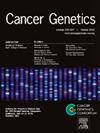High YEATS4 expression characterizes MDM2-amplified liposarcoma
IF 2.1
4区 医学
Q4 GENETICS & HEREDITY
引用次数: 0
Abstract
YEATS4 resides within the 12q13–15 chromosomal region, where it is frequently co-amplified with MDM2 and CDK4 in liposarcomas (LPS). However, its independent role in LPS progression and dedifferentiation remains poorly defined. In this study, YEATS4 expression was analyzed in 57 formalin-fixed paraffin-embedded (FFPE) LPS samples using quantitative real-time PCR and compared across histological subtypes. MDM2 amplification status was determined by fluorescence in situ hybridization (FISH). The functional relevance of YEATS4 was assessed via siRNA-mediated knockdown in two well-differentiated LPS (WDLPS) cell lines, GOT-3 and 93T449. Relative YEATS4 mRNA expression was significantly higher in MDM2-positive compared to MDM2-negative tumors (median = 0.413 vs. 0.007; p = 0.008). Using the median YEATS4 expression value (0.227) – calculated from WDLPS and DDLPS cases only – as a threshold, high YEATS4 expression was observed in 64% of high-grade dedifferentiated LPS (DDLPS), 54% of low-grade DDLPS, and 29% of WDLPS cases (p = 0.302). Functionally, YEATS4 silencing significantly reduced cell viability in 93T449 cells at Days 5 (24.1%) and Day 7 (22.1%) compared to control (p < 0.001). In GOT3 cells, a slight reduction was noted at Day 3 (7.6%) which was not sustained. In summary, YEATS4 could contribute to LPS progression in a subset of MDM2-amplified tumors, particularly in high-grade DDLPS. Its variable functional impact across models highlights the complexity of the 12q13–15 amplicon and supports further investigation into YEATS4 as a potential molecular marker and therapeutic target in LPS.
YEATS4高表达是mdm2扩增型脂肪肉瘤的特征
YEATS4位于12q13-15染色体区域,在脂肉瘤(LPS)中,它经常与MDM2和CDK4共同扩增。然而,其在LPS进展和去分化中的独立作用仍不明确。在本研究中,采用实时荧光定量PCR分析了57份福尔马林固定石蜡包埋(FFPE) LPS样品中YEATS4的表达,并比较了不同组织学亚型。采用荧光原位杂交法(FISH)检测MDM2扩增状态。在两种分化良好的脂多糖(WDLPS)细胞系GOT-3和93T449中,通过sirna介导的敲低来评估YEATS4的功能相关性。与mdm2阴性肿瘤相比,mdm2阳性肿瘤中YEATS4 mRNA的相对表达量显著升高(中位数= 0.413 vs. 0.007; p = 0.008)。使用YEATS4中位表达值(0.227)(仅从WDLPS和DDLPS病例计算)作为阈值,在64%的高级别去分化LPS (DDLPS)、54%的低级别DDLPS和29%的WDLPS病例中观察到高水平的YEATS4表达(p = 0.302)。在功能上,与对照组相比,YEATS4沉默显著降低了93T449细胞在第5天(24.1%)和第7天(22.1%)的细胞活力(p < 0.001)。在GOT3细胞中,在第3天注意到轻微的减少(7.6%),但没有持续。总之,YEATS4可能在mdm2扩增的肿瘤亚群中促进LPS进展,特别是在高级别DDLPS中。它在不同模型中的不同功能影响突出了12q13-15扩增子的复杂性,并支持进一步研究YEATS4作为LPS的潜在分子标记和治疗靶点。
本文章由计算机程序翻译,如有差异,请以英文原文为准。
求助全文
约1分钟内获得全文
求助全文
来源期刊

Cancer Genetics
ONCOLOGY-GENETICS & HEREDITY
CiteScore
3.20
自引率
5.30%
发文量
167
审稿时长
27 days
期刊介绍:
The aim of Cancer Genetics is to publish high quality scientific papers on the cellular, genetic and molecular aspects of cancer, including cancer predisposition and clinical diagnostic applications. Specific areas of interest include descriptions of new chromosomal, molecular or epigenetic alterations in benign and malignant diseases; novel laboratory approaches for identification and characterization of chromosomal rearrangements or genomic alterations in cancer cells; correlation of genetic changes with pathology and clinical presentation; and the molecular genetics of cancer predisposition. To reach a basic science and clinical multidisciplinary audience, we welcome original full-length articles, reviews, meeting summaries, brief reports, and letters to the editor.
 求助内容:
求助内容: 应助结果提醒方式:
应助结果提醒方式:


